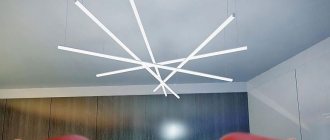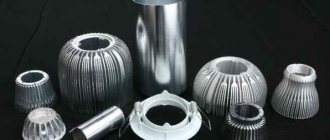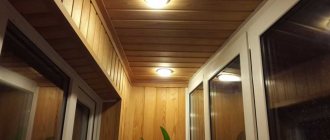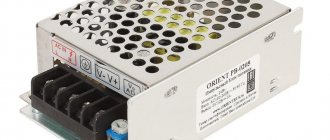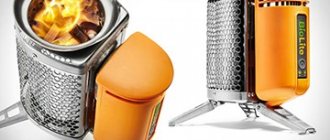Natural lighting does not make it possible to create adequate conditions for underwater inhabitants. It illuminates the tank unevenly. In winter, the length of the day is noticeably reduced. In this regard, it is impossible to do without the use of artificial lighting. Therefore, below we will tell you how to do it DIY LED aquarium lighting using inexpensive and accessible materials.
LED lighting is used to implement decorative functions and create an optimal habitat for plants and organisms. The importance of LED lamps is due to the following reasons:
- Possibility of creating effective lighting intensity.
- High quality LED lamps.
- Long period of exposure to lighting.
Main features of LED lamps
The advantages of this light source are as follows:
- Low energy consumption. Despite the high operating power, the lamps in the aquarium work efficiently.
- The lamp body does not heat up during operation. There is no need to worry about having an additional source of cooling in the aquarium.
- Effective illumination of every corner of the aquarium thanks to the presence of a directed light flux.
- Availability of various color combinations. You can easily install lighting of the required spectrum in the aquarium.
- Maintaining high quality work, even after time. The light spectrum remains unchanged.
- Long service period. The average service life is 30,000–60,000 hours.
Thanks to the long period of operation, you will not often have to wonder about replacing the ice lighting source. Moreover, arrays consisting of several light bulbs can be used. There are no disadvantages to this aquarium device. The only thing I would like to note is that it has recently appeared on the modern market, so this device is not widely distributed.
Why is light needed?
Without the sun or artificial light there is no life.
Without light, algae and plants will not be able to function .
Due to lack of lighting, algae die in the shortest possible time. The process of photosynthesis will not produce oxygen, which is needed for most physiological processes. Oxygen is necessary for fish to breathe and live actively. Lack of lighting affects aquatic life the least painfully. Aquarium fish need a consistent “life regimen”. Lighting during the day should be different from lighting at night. Too much lighting or its complete absence for a long period can lead to various diseases and death of aquarium inhabitants. This fact has been proven by numerous studies conducted by experienced specialists. Lighting also affects the reproduction, activation of growth, development, and life expectancy of aquatic inhabitants.
Choosing LED lamps for your aquarium wisely
The selection of light bulbs for an aquarium should be based on two key parameters. The first is the intensity of the light flux. The second is color temperature. When choosing a lamp, pay attention to the lumen/W indicator. The higher it is, the greater the energy efficiency, that is, the efficiency of the light source. Also pay attention to the pulsation coefficient of the light flux - let it be less than 5%, ideally 1%. Higher values of this indicator will lead to increased eye fatigue, and why do you need an aquarium that negatively affects your health.
Each aquarium light has a different color temperature range. In an aquarium it should not be less than 5500 K. The ideal solution is if the color temperature is 6000–8000 K.
If an ice light source with a value of less than 4000K or lower is selected, the light will be excessively yellow. Conversely, a value of more than 6000K indicates a predominance of blue color. The most favorable color palette for an aquarium is warm white, cool white or daylight.
The quality level of the light source is no less important. You should not buy overly cheap lamps. They have an increased glow intensity only during the first time of use. After a certain period of time, the process of degradation of the light source can be observed, which negatively affects the inhabitants of the flora and fauna of an artificial home pond. The choice of lamp shade is an individual decision of the tank owner.
Selecting power and number of LEDs
Illumination rate:
- aquarium without plants is 0.1-0.3 W/l,
- with shade-loving plants and fish: 0.2-0.4 W/l,
- herbalist with light-loving fish: 0.5-0.8 W/l,
- with a large number of plants: 0.8-1 W/l.
When using LED lamps, the results obtained should be divided by 7.
An important point in the calculation is the depth of the container.
As can be seen from the figure, with an initial illumination of 2000 Lux, the illumination at the bottom of 50 cm is 60.50 Lux. That is, the illumination decreases approximately by half every 10 cm. 60 Lux is the minimum value that you need to focus on when installing light bulbs for an aquarium.
The luminous flux is usually indicated by the manufacturer on the packaging, but there are also special tables on the Internet.
Some flux values of LED lamps are shown in the table.
| LED light bulb power, Watt | Luminous flux, Lm |
| 2-3 | 250 |
| 4-5 | 400 |
| 6-10 | 700 |
| 10-12 | 900 |
| 12-15 | 1200 |
| 18-20 | 1800 |
| 25-30 | 2500 |
| 30-40 | 3 500 |
| 40-60 | 8 000 |
| 80-120 | 12 000 |
| 140-160 | 20 000 |
| 180-200 | 30 000 |
What is the best way to install LED lamps?
You can easily install LED lamps in an aquarium with your own hands. During this work, in order to achieve the most comfortable microclimate in the tank and an attractive visual effect, it is important to do this work correctly. When mounting lamps on top, a cover glass should be provided to help prevent excessive evaporation of liquid, fish jumping out, or water droplets falling onto the bulbs. To save electrical energy, we recommend installing a timer that will automatically turn off the lights according to a given pattern.
The main thing is to light the aquarium in such a way that all the needs of living beings and plants are satisfied. If you notice, for example, that the algae are not as bright as before, and the fish have turned pale, then there is a high probability that the backlight is installed poorly. Rotting of plant roots indicates that the LEDs are not directed towards their roots.
It should be noted that the abundance of light is also a mistake in setting the correct amount of lighting. In such a situation, the water blooms and there is a green coating on the walls.
The influence of different colors on aquarium fauna
Red and orange are of great importance for the photosynthesis of aquarium plants and enhance the formation of carbohydrates.
Blue and violet LEDs are needed to slow down the growth of stems. This light prevents plants from stretching out and makes them compact, which helps improve absorption. This creates a favorable environment and improves aesthetics.
The green color can be useful to give the algae a bright green color. Its rays pass completely through the leaf plates and are not absorbed. The leaf becomes thin and the stem becomes elongated due to low photosynthesis.
The yellow color is as close as possible to what it would be like in nature. The surface of the water surface does not reflect yellow rays, unlike white ones, and thereby creates natural light.
In order for the inhabitants of the aquarium to be healthy, it is necessary to correctly select both the color and intensity of lighting. It is necessary to take into account the environment in which certain species of fish lived.
For example, some residents of tropical climates do not receive bright light in wildlife even on hot sunny days. Therefore, at the genetic level, they have a low need for bright rays. Excessive lighting can cause stress and even lead to illness. Inhabitants of shallow waters with clear water, on the contrary, are light-loving. For corals that come from shallow waters, good UV radiation is important, as ultraviolet light promotes photosynthesis.
How to light an aquarium
There are two simple ways to organize lighting. The first method is the simplest. DIY LED lighting for an aquarium will help significantly reduce your costs. You will need an LED strip.
Next, you simply carefully stick it around the perimeter of the structure. Please note that lighting an aquarium with LED strip will make the lighting as uniform as possible, although it will not be energy efficient enough. This tape is sold in a skein. On one side of the tape there are LEDs, and on the other there is double-sided tape. But you should keep in mind that this type of lighting is not the only source for your aquarium. To create complete lighting, it is advisable to use additional T5 or T8 LED lamps. The place where the tape and cord are fixed must have insulation based on silicone filler.
The second lighting method is the installation of LED lamps. It is more popular and allows you to create complete and high-quality lighting of the entire tank. It is not difficult to assemble an LED lamp for an aquarium with your own hands. The lamp consists of a certain number of lamps. How many of them should you take? For a container of 200–300 liters you will need 40 spot lamps. Each bulb must be rated at 270 lumens (3 watts each).
DIY tank lighting with LED lamps
If you first study useful information, installing aquarium lamps will not cause difficulties. Installation of lamps involves the sequential implementation of the following stages:
- Preparation of necessary materials for work. We will need 6-7 LED lamps (3 W, 270 lm, 6000 K) with cold light and about 3-4 pieces oriented towards warm light (3000 K). Based on individual wishes, you can take others.
You should also prepare a gutter or panel made of plastic with parameters of 200 cm by 100 cm. You cannot do without a 12 W power supply and wires (2 mm). The number of 3 W lamps must be selected taking into account the volume of the aquarium. One piece is equivalent to 12–16 liters of tank. For example, if you have a 200 liter aquarium, then you will need about 30 3 W lamps to create good conditions for the inhabitants. For drilling you will need a 48 mm cutter and connector sockets (GU5.3; MR16; MR11) about 10 pieces (for the number of lamps). A fan will be needed if necessary. - It is necessary to insert our lamps into a plastic panel or trough. The length and width of the gutter are selected taking into account the parameters of the aquarium for lamps with LEDs. There are approximately 10 holes per 100 cm. The holes are made using a milling cutter. The lamps are connected to the installed connectors.
- Connecting LED lamps.
It is produced in parallel with the existing power source. For example, you can use a power supply from a personal computer. Only the necessary outputs of the power supply connector are connected. Below is a diagram. - We install a lamp and a fan. For cooling, you can use any computer fan.
Selection of floodlights
When choosing an LED spotlight, you need to understand what its features are and which option is suitable for an aquarium. When illuminating plants, it is worth buying products that emit white light; for algae, a yellow tint will be more pleasant. The color spectrum should be red, as it has a beneficial effect on plants and stimulates their growth. If there are flowering crops inside the tank, then you need to place a blue lamp in front of the aquarium.
To make aquatic inhabitants comfortable, it is recommended to use mixed light. To create a particular spectrum, you need to focus on the temperature of the lighting fixtures. Highlight:
- warm;
- neutral;
- cold light.
LED lamps are usually used in closed aquariums, mounted under the lid of the product. If the tank is open, then installing floodlights would be optimal. Depending on the size of the container, you can select the number of lighting fixtures and their power. You can use outdoor spotlights if the intensity of their illumination does not exceed the limits necessary for the normal growth and habitation of the inhabitants of the aquarium.
Spotlights can have different types of diodes:
- The COB is one large diode inside the product;
- SMD is a lot of small diodes.
There are varieties with and without a driver. The first option is considered to be of higher quality, as it allows you to work from different voltages. To check how smooth and uniform the light from the spotlight will be, you need to point your phone camera at it. If there are stripes and noise on the screen, then the light is uneven, and if the image does not change significantly, then this is the best option for use in an aquarium. Proven options are the Soyuz and TDM SDO 10-2N products.
Summing up - LED lamps for an aquarium - how profitable are they?
From the information described above, we can conclude that installing LED lamps for an aquarium does not cause additional difficulties. Having previously read the literature on this issue, you can easily install them in a tank using a self-created lamp. Do-it-yourself LED aquarium lighting organized in this way has a large number of advantages. It creates high-quality and complete lighting for underwater inhabitants, is economical, and has a varied combination of colors. The only disadvantage of using lamps is their relatively high cost. However, over time, these products easily pay for themselves. The aquarium operates in energy-saving mode.
Advantages of diode devices
Diode lamps have been used for aquarium lighting since recent times, but have already managed to displace many analogues from their leading positions. This is not surprising, because diodes have a large number of undeniable advantages.
- Economical. In addition to the fact that the cost of devices is significantly lower than competitive products, LEDs are able to reproduce beams with increased brightness with minimal electricity consumption.
- High strength. Regardless of the type of diodes, they have an increased degree of strength and therefore are not susceptible to mechanical stress. Due to the absence of a spiral, they do not respond to vibrations.
- Operational life. The design can serve properly for more than 5 years, which is several times higher than its analogues.
- Choice. Thanks to the spectral range, you can choose the most optimal option for both fish and plants.
Backlight color may vary
- Safety. Since the lamps operate on low voltage, with open contacts they are not capable of causing much harm to the user. They can also be classified as fireproof light sources, since they have a protective layer against moisture.
- Temperature. Even with continuous operation for 7-10 hours, the elements do not emit excess heat. Thus, the desired temperature is always maintained in the container.
VIDEO: DIY waterproof aquarium lighting
